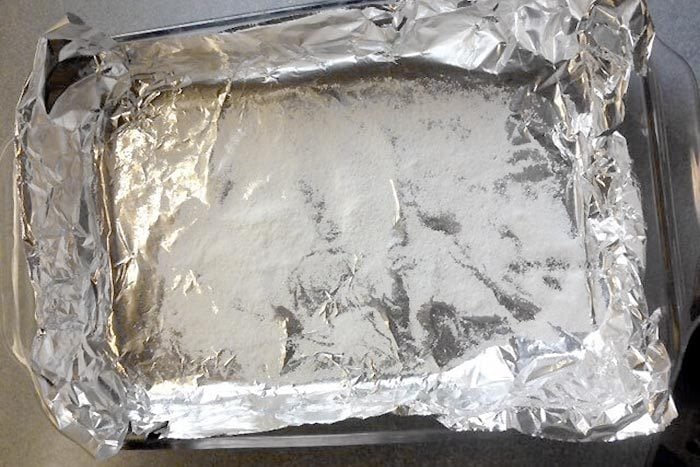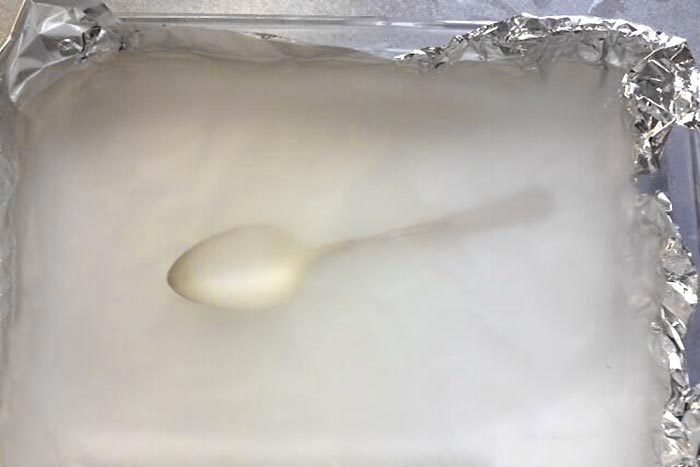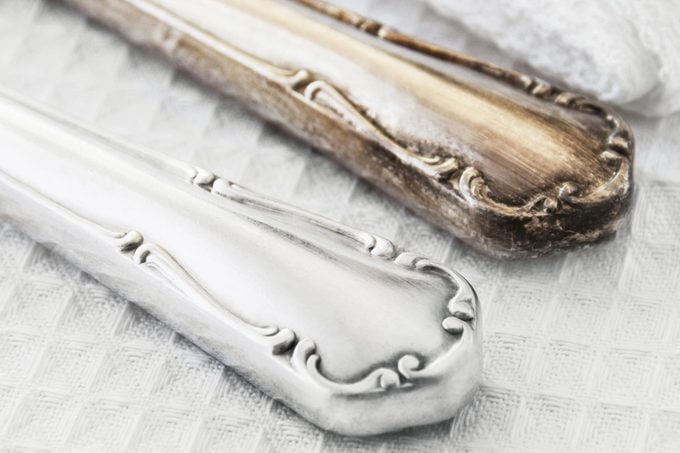How to Clean Silver, Just Like Grandma Did
Updated: May 19, 2023

Learn how to clean silver and remove tarnish in minutes—with items right from your pantry.
If you’ve been lucky enough to inherit Grandma’s precious sterling silverware, or have a set of your own, it’s fun to set a beautiful table for a festive Thanksgiving feast, Christmas Eve dinner or Easter brunch. But when silverware isn’t used and washed often, it can easily tarnish, leaving it dull, discolored and unappetizing. You can use commercial silver polish to spruce it up; but if you’re wondering how to clean silver without any harsh chemicals, there’s an easy, natural way to clean silverware—and the secret is right in your pantry.
Interested in cleaning the rest of your dining area? Check out our guide for how to clean your dining room.
How to Clean Silver with Pantry Ingredients
Tools
- Aluminum foil
- 2 tablespoons baking soda
- 2 tablespoons salt
- Hot, almost boiling, water
- Plastic or glass container
- Soft cloth or lint-free dish towel
Directions for Cleaning Silverware
This works for other silver pieces, too!
Step 1: Grab a pan

Choose a plastic or glass container that will accommodate your silver pieces. Line the bottom of the container with a piece of aluminum foil, shiny side up.
Psst: Find more uses for aluminum foil.
Step 2: Layer with baking soda and salt
Sprinkle baking soda and salt across the bottom. Gently shake the pan to distribute evenly.
Step 3: Add silverware
Add your silverware to the container, making sure each piece is touching the aluminum foil. (If you have a lot of silver to clean, do it in smaller batches, using fresh materials for each batch.)
Step 4: Start the reaction
Pour the hot water over the silverware to cover. (Because of the baking soda, the water will foam up, so make sure you have enough room for expansion.) A chemical reaction from the foil, soda, salt and hot water binds the silver sulfide, or tarnish, from the silver item onto the foil. This may cause the foil piece to become dark.
Step 5: Let the silverware soak

Allow the silverware to soak 1 to 2 minutes, or up to 5 minutes if it’s heavily tarnished. Remove the silverware from the container, wash with warm, soapy water, and dry thoroughly with a soft cloth. (This is why our cleaning experts love microfiber cloths.) If you have really stubborn tarnish, repeat this process again with fresh materials.
How to Clean Large Silver Items
If you are cleaning a large piece like a teapot or bowl, you can use up to 1/2 cup baking soda and 1/2 cup salt in a non-stainless steel sink (the two metals could react, causing spots) or a deeper container if need be. Just keep the amount of baking soda and salt equal.
Other Ingredients That Clean Silver
Vinegar
For heavily tarnished pieces, boost the cleaning power of salt, baking soda and aluminum foil by adding some vinegar to the equation. After combining the salt and baking soda in the pan, add 1/2 cup of distilled white vinegar before pouring in the hot water.
Laundry Detergent
Forgot to restock the salt or baking soda in your pantry? Drizzle a tablespoon of laundry detergent over the aluminum foil instead, then add your silverware and hot water.
Toothpaste
To make your silver shine, rub a small amount of toothpaste on a piece of silver and buff gently in a circular motion with a soft cloth (there’s that microfiber again). Wash in warm, soapy water and dry thoroughly with a fresh cloth.
Lemon Juice
For stubborn tarnishing or water spots, apply fresh lemon juice to your silver with a soft microfiber cloth and buff gently.
Tips for Cleaning Silver

- Never put your sterling silver in the dishwasher, because it can damage the pieces.
- Certain foods like eggs, onions and mustard can make silver tarnish faster. Wipe or rinse those foods off immediately after eating.
- Avoid exposing sterling silver to tarnish-producing materials like wool, rubber, felt and latex.
How to Care for Silver
After using your silver, hand-wash the silverware with dish soap, warm water and a soft sponge. Hand-dry your silver with a soft microfiber cloth, gently buffing to revive its shine, before returning your sterling silverware to storage.
How to Polish Silver
Though salt, baking soda, aluminum foil and water are usually enough to restore your sterling silverware, there are many commercial silver polishes on the market that you can try if your silver is stubbornly tarnished. Some polishes, like W. J. Hagerty 10080 Silversmiths’ Silver Polish, contain additives that help prevent silver from tarnishing over time.
Before using any sort of silver polish, always read the instructions and follow them carefully. Also note that polishing silver should be an occasion, only done once or twice a year, and not too frequently as over time it would remove the silver.
How to Remove Scratches from Silver
If pieces have become scratched with wear, try using a polishing cloth specifically made for silver to buff out the scratches. Clean and remove any tarnish first, then buff in a circular motion until you see results. Note that unlike the chemical reaction that removes tarnish from the surface as in the steps above, this process will remove a fine layer of silver each time. That’s another good reason why storing your silver properly to avoid scratching will help prolong its beauty.
How to Store Silver
Knowing how to clean silver isn’t the only way to care for it—storing it in the right environment is just as important so that your freshly cleaned sterling silverware can stay pristine. Ideally, sterling silver should be stored in a lined flatware chest. Wooden chests are the most traditional storage option for silverware, but there are more modern options, like this brightly colored Hagerty Silver Flatware Storage Tray, which you can tuck into a drawer or linen closet.
Short of that, the drawers of a china cabinet or a separate lined drawer in an area with low humidity are your best bet. Keep the silverware free of dust, and don’t jumble it together in a drawer with stainless steel flatware. Add a small piece of white chalk to the chest or drawer to help absorb moisture.
Create a Legacy
For each girl born into my extended family, my grandparents gifted a piece of new sterling silverware in a unique pattern for every birthday and Christmas (silver was much cheaper then!). By the time I was an adult, I had eight place settings and several serving pieces to use for hosting holidays and special occasions. While I don’t use my sterling silver often, I’m so happy I have it and the loving memories of shared meals with friends and family that go with it.
Use these simple tips on how to clean silver to keep your sterling set in good condition, and you’ll have a priceless heirloom that can be passed down from generation to generation.
Research contributed by Allison Robicelli.
